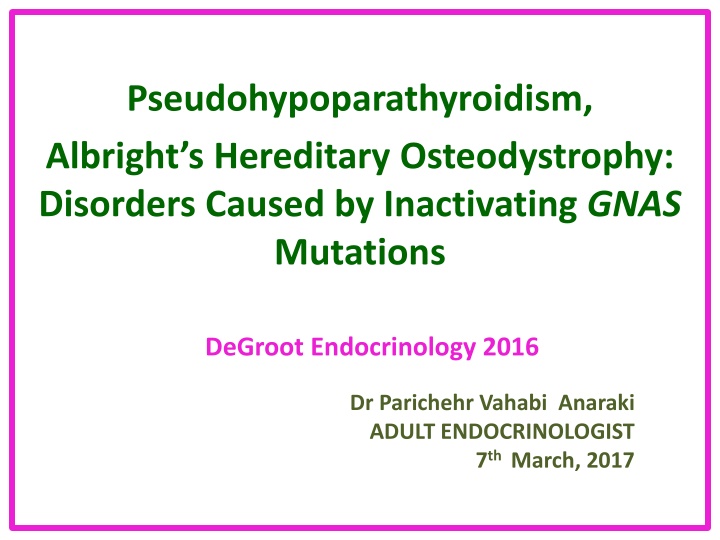Pseudohypoparathyroidism and PHP Clinical Features
Pseudohypoparathyroidism (PHP), also known as Albright's Hereditary Osteodystrophy, is a rare disorder caused by inactivating GNAS mutations leading to PTH resistance in the renal proximal tubule. Patients with PHP exhibit physical traits such as obesity, short stature, and cognitive impairment, along with hypocalcemia and hyperphosphatemia. This condition results in reduced serum 1,25(OH)2D levels and can manifest as symptomatic hypocalcemia. Despite PTH resistance in the proximal tubule, PHP patients may have elevated PTH levels that help prevent hypocalcemia through actions on bone and the renal distal tubule.
Download Presentation

Please find below an Image/Link to download the presentation.
The content on the website is provided AS IS for your information and personal use only. It may not be sold, licensed, or shared on other websites without obtaining consent from the author.If you encounter any issues during the download, it is possible that the publisher has removed the file from their server.
You are allowed to download the files provided on this website for personal or commercial use, subject to the condition that they are used lawfully. All files are the property of their respective owners.
The content on the website is provided AS IS for your information and personal use only. It may not be sold, licensed, or shared on other websites without obtaining consent from the author.
E N D
Presentation Transcript
Pseudohypoparathyroidism, Albright s Hereditary Osteodystrophy: Disorders Caused by Inactivating GNAS Mutations DeGroot Endocrinology 2016 Dr Parichehr Vahabi Anaraki ADULT ENDOCRINOLOGIST 7th March, 2017
In 1942, Albright and colleagues1 described a group of patients who displayed certain physical features, including obesity, short stature, brachydactyly, and cognitive impairment, combined with hypocalcemia and hyperphosphatemia. In these patients, exogenous, biologically active parathyroid hormone (PTH) extracts failed to result in a full phosphaturic response;hence, the term pseudohypoparathyroidism (PHP) was introduced
The primary site of PTH resistance in PHP is the renal proximal tubule, as the actions of PTH in bone and the distal tubule appear normal
Patients with PHP have reduced serum concentrations of 1,25-dihydroxyvitamin D [1,25(OH)2D], which is the main cause of hypocalcemia. Both low serum 1,25(OH)2D and hyperphosphatemia are the direct results of PTH resistance at the proximal tubule.
Hyperphosphatemia is typically worsened by the elevation of PTH in the circulation and the absence of resistance to the bone resorptive actions of this hormone; on the other hand, the increase in serum PTH can prevent symptomatic hypocalcemia in some PHP patients due largely to its unimpaired actions on the bone and the renal distal tubule, and thus calcium release from bone and enhanced calcium reabsorption, respectively.
However, at some point in their lives, most patients manifest hypocalcemia and, therefore, present with associated clinical findings
PTH exerts its actions by binding to a seven- transmembrane, G protein coupled receptor (the PTH/PTH-related protein receptor, PTHR1). Although the PTHR1 can couple to several different G proteins,16 most PTH actions are mediated primarily through the stimulatory G protein, which acts on adenylyl cyclases, thereby increasing the formation of intracellular second-messenger cyclic adenosine monophosphate (cAMP).
PTH-induced cAMP formation is used as an important indicator of renal tubular PTH function, since most PHP patients display an inadequate or absent increase of urinary cAMP in response to exogenous, biologically active PTH
However, currently used high- sensitivity PTH assays often suffice to make the diagnosis when serum PTH is elevated in the presence of hypocalcemia and hyperphosphatemia
Nonetheless, depending on the nature of the nephrogenous response to exogenous PTH, PHP is subdivided into two main types. PHP type 1 is defined by blunted urinary excretion of both cAMP and phosphate, and PHP type 2 is defined by blunted urinary excretion of phosphate only.
Signs and Symptoms
Signs and symptoms of decreased serum calcium level often reflect secondary prolongation of the QT interval on EKG and increased neuromuscular excitability leading to Trousseau s and Chvostek s signs as well as bronchospasm. In more severe cases, patients present with seizures. Other neurologic symptoms can also arise from hypocalcemia, and some patients with PHP have initially been diagnosed with movement disorders.
As another complication of the changes in serum calcium and phosphorous, brain imaging studies frequently show intracranial calcifications in PHP patients
PHP is a congenital disorder, but only few reports describe findings consistent with PTH resistance during the neonatal period. Clinical manifestation of hypocalcemia typically occurs only later in childhood, suggesting that PTH resistance and the resultant changes in serum calcium and phosphorous develop only gradually
It thus appears that PTH responses are intact during the early postnatal period despite the existence of the molecular defect underlying PHP. The mechanisms that allow normal PTH signaling during this developmental stage remain unknown
PSEUDOHYPOPARATHYROIDISM TYPE 1a
PSEUDOHYPOPARATHYROIDISM TYPE 1a: Of the two main PHP types, PHP type 1 is much more common. Various clinical variants of PHP type 1 have been described based on the presence or absence of clinical manifestations that coexist with PTH resistance, diminished stimulatory G protein activity in easily accessible cells, and silenced expression of the GNAS-derived -subunit of the stimulatory G protein (Gs )
PSEUDOHYPOPARATHYROIDISM TYPE 1a: PHP patients often exhibit characteristic physical features that may include obesity, round facies, short stature, brachydactyly, ectopic ossification, and mental impairment. These features are termed Albright s hereditary osteodystrophy (AHO) and occur primarily in PHP patients who are now classified as having pseudohypoparathyroidism type 1a (PHP 1a).
PSEUDOHYPOPARATHYROIDISM TYPE 1a The brachydactyly observed in patients with AHO typically involves the metacarpal and/or metatarsal bones and, thus, the pattern of shortening of the hand bones differs from other disorders with brachydactyly, such as familial brachydactyly and Turner s syndrome
PSEUDOHYPOPARATHYROIDISM TYPE 1a Due to shortened metacarpals, dimpling over the knuckles of a clenched fist (Archibald sign) is often observed. The shortening of the distal phalanx of the thumb, however, is the most common skeletal abnormality (called murderer s thumb or potter s thumb), and some patients have shortening of all digits
PSEUDOHYPOPARATHYROIDISM TYPE 1a Mental impairment is mild, often presenting as cognitive defects. It is possible that the cause of mental impairment is the deficiency of Gs signaling in the brain. There is remarkable patient-to-patient variability in AHO, even among patients that carry the same genetic mutation and belong to the same family
PSEUDOHYPOPARATHYROIDISM TYPE 1a Some patients may exhibit a single AHO feature only, such as obesity, while others may present with multiple AHO features. Furthermore, the severity of each feature differs vastly among the patients. In addition, individual AHO features are not unique to PHP, as they can be observed in other unrelated disorders
PSEUDOHYPOPARATHYROIDISM TYPE 1a The variable expressivity and the lack of specificity of individual features can make the AHO diagnosis challenging. While the coexistence of hormone resistance in PHP 1a patients is often helpful, it can also be misleading. This is particularly important for the differential diagnosis of different PHP forms characterized by the presence of AHO features alone or hormone resistance alone
PSEUDOHYPOPARATHYROIDISM TYPE 1a In addition to having PTH resistance and AHO,patients with PHP 1a show clinical evidence that is consistent with target-organ resistance to other hormones. The most common additional hormone resistance involves the actions of TSH, leading to hypothyroidism
PSEUDOHYPOPARATHYROIDISM TYPE 1a Unlike PTH resistance, which typically develops later in life, TSH resistance can be present at birth. Resistance to gonadotropins and growth hormone releasing factor has been reported, whereas resistance to other peptide hormones that also mediate their actions through Gs -coupled receptors, such as vasopressin or ACTH, does not appear to become clinically overt
PSEUDOHYPOPARATHYROIDISM TYPE 1a The genetic mutation that causes PHP 1a is located within the Gs -coding GNAS exons. A protein that is essential for the actions of many hormones, Gs primarily mediates agonist-induced generation of intracellular cAMP. Activation of a stimulatory G protein coupled receptor by its agonist, such as PTH, leads to a GDPGTP exchange on Gs , causing dissociation of the latter from G subunits
PHP type 1a: This allows both Gs and G to stimulate their respective effectors. In its GTPbound state, Gs can directly activate several different effectors, such as Src tyrosine kinase,63 and certain Cachannels. Apart from these effectors, however, adenylyl cyclase is by far the most ubiquitous and the most extensively investigated effector molecule stimulated by Gs . An integral membrane protein, adenylyl cyclase catalyzes the synthesis of the ubiquitous cAMP, which then triggers various cell-specific responses.
PHP type 1a: The activation of adenylyl cyclase and other effectors by Gs is regulated by the intrinsic GTP hydrolase (GTPase) activity of Gs . Conversion of GTP into GDP results in the re- assembly of the G protein heterotrimer and, thereby, prevents further effector stimulation
PHP type 1a: Mutations identified in PHP 1a patients are heterozygous and scattered throughout all of the 13 GNAS exons encoding Gs and the intervening sequences, including missense and nonsense amino acid changes, insertions/ deletions that cause frameshift, and nucleotide alterations that disrupt pre-mRNA splicing
PHP type 1a: Consistent with this mutational spectrum, Gs level/activity is reduced by approximately 50% in easily accessible tissues from PHP 1a patients, such as erythrocytes, skin fibroblasts, and platelets. Deficiency of Gs has also been demonstrated in renal membranes from a patient with PHP
PHP type 1a: The detection of reduced Gs activity is important for the establishment of PHP 1a diagnosis, particularly for cases in which genetic analysis fails to reveal a GNAS mutation. Reduction of Gs activity in PHP 1a is consistent with the fact that PTH and the other hormones with impaired actions in this disorder act via cAMP- mediated signaling pathways.
PHP type 1a: A missense mutation in exon 13 (A366S) was identified in two unrelated boys, who presented with PHP 1a and precocious puberty. This mutant Gs protein is temperature- sensitive and thus rapidly degraded at normal body temperature. The amino acid substitution, however, renders the protein constitutively active, resulting in elevated cAMP signaling in the cooler temperature of the testis. More recently, another mutant Gs protein has been described in a unique case of familial PHP 1a and transient neonatal diarrhea.
PHP type 1a: Another pediatric case has been described in whom a de novo missense mutation (R231C) on the paternal allele was found together with a maternally inherited combination of three C-to-T substitutions, resulting in aberrant GNAS splicing. The patient with these compound heterozygous mutations had morbid obesity, TSH and PTH resistance, and a prothrombotic state due to marked Gs hypofunction in platelets.
PHP Paternal Gs expression is silenced in a small subset of tissues through as-yet-undefined mechanisms, so that the maternal allele is the predominant source of Gs expression. These tissues include the renal proximal tubule, thyroid, pituitary, and gonads
PHP: Although devoid of differential methylation, the Gs promoter exhibits parent-of-origin specific histone modifications in those tissues where it is monoallelic. The active maternal Gs promoter shows a greater ratio of tri- to di-methylated histone-3 Lys4 compared to the silenced paternal promoter in the proximal tubule, whereas the amount of methylated histones is similar in maternal and paternal Gs promoters in liver, a tissue in which Gs is biallelic. As discussed later, the tissue-specific, paternal Gs silencing has a key role in the development of PTH resistance in patients with PHP 1a and PHP 1b.
PHP 1c has been described as a distinct variant of PHP 1a but the clinical and laboratory features of patients with PHP 1c are identical to those with PHP 1a, as they have both AHO and multihormone resistance. In contrast to PHP 1a, however, biochemical assays demonstrate no reduction in Gs activity in erythrocytes obtained from PHP 1c patients, suggesting the absence of mutations within the Gs gene. Nevertheless, recent molecular characterizations have revealed Gs mutations at least in some PHP 1c patients.
CLINICALLY DISTINCT, GENETICALLY RELATED PHP 1a VARIANTS 1-Pseudopseudohypoparathyroidism 2-Progressive Osseous Heteroplasia
Pseudopseudohypoparathyroidis m Physical abnormalities similar to those observed in patients with PHP 1a but without evidence for an abnormal regulation of calcium and phosphate homeostasis were first reported in 1952. Because of the lack of an abnormal regulation of mineral ion homeostasis, the name pseudopseudohypoparathyroidism (PPHP) was coined to describe this disorder.:
Pseudopseudohypoparathyroidism: Interestingly, patients with PPHP also carry GNAS mutations that lead to diminished Gs function, and these mutations can be found in the same kindred as those with PHP 1a. However, both disorders are never seen in the same sibling kinship, and a careful analysis of multiple families has revealed that the mode of inheritance of each disorder depends on the gender of the parent transmitting the Gs mutations:
Pseudopseudohypoparathyroidism : Thus, an inactivating Gs mutation causes PHP 1a (i.e., hormone resistance and AHO) after maternal inheritance, whereas the same mutation on the paternal allele results in PPHP (AHO only).
Pseudopseudohypoparathyroidis m Most AHO features, except obesity and mental retardation, appear to develop regardless of the parent of origin, and it is therefore primarily hormone resistance that displays an imprinted mode of inheritance. Recent studies have furthermore revealed that most PPHP patients are considerably smaller at birth, particularly if their inactivating Gs mutation is located in GNAS exons 2 to 13 of the paternal allele:
Pseudopseudohypoparathyroidis m The tissue-specific imprinting of Gs expression can explain the parent-of-origin specific inheritance of hormone resistance. In those tissues where Gs expression is paternally silenced (i.e., Gs is expressed exclusively or predominantly from the maternal allele), an inactivating mutation located on the paternal allele is not predicted to alter Gs function, whereas the same mutation located on the maternal allele is predicted to abolish Gs function completely
Pseudopseudohypoparathyroidism Hormone resistance is observed in those tissues where Gs is imprinted, such as the proximal renal tubule and the thyroid gland, while hormone responses are unimpaired in those tissues where Gs is biallelic, such as the distal renal tubules.
A recent study furthermore showed that the silencing of the paternal Gs allele in the renal proximal tubule develops after the early postnatal period in mice, thus providing a plausible explanation for the finding that the manifestation of PTH resistance occurs mostly after infancy in patients with PHP 1a and PHP 1b
PPHP: The finding that most AHO features develop regardless of the parent transmitting a Gs mutation has led to the hypothesis that the inheritance of AHO is due to Gs haploinsufficiency in various tissues, which appears to be true in certain settings. PTHrP-induced cAMP generation is critical for proper control of hypertrophic differentiation of growth plate chondrocytes,152 and Gs haploinsufficiency has been demonstrated in this tissue through the study of mice chimeric for wild-type cells and mutant cells heterozygous for disruption of GNAS exon 2.153
PPHP: Regardless of the parental origin of the GNAS exon 2 disruption, the mutant cells displayed premature hypertrophy compared to their wild- type neighbors, although the paternal disruption (i.e., loss of one Gs allele combined with a complete loss of XL s) resulted in significantly more premature hypertrophy than the maternal disruption (loss of one Gs allele only). Thus, the brachydactyly and/or short stature observed in the context of AHO likely result from diminished Gs signaling in growth plate chondrocytes
PPHP: While these data correlate well with the notion that AHO develops after both maternal and paternal inheritance of a Gs mutation, recent evidence suggests that individual AHO features can also be subject to imprinting
PPHP: A careful analysis of multiple patients with PHP 1a and PPHP revealed that obesity is primarily a feature of PHP 1a patients, developing after maternal inheritance. Considering that Gs is biallelic in the white adipose tissue, it was proposed that Gs may also be imprinted (predominantly maternal expression) in areas of the central nervous system that control satiety and body weight























